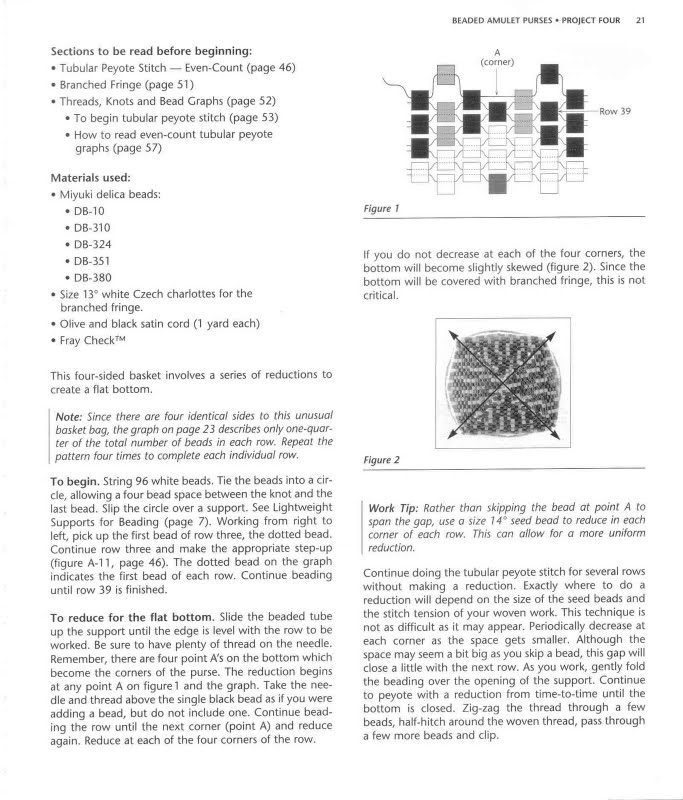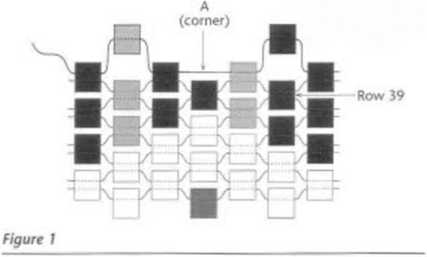21

BEADED AMULET PURSES • PROJECT FOUR 21
Sections to bo read before beginning:
• Tubular Peyote Stitch — Even-Count (page 46)
• Branched Fringe (page 51)
• Threads, Knots and Bead Craphs (page 52)
• To begin tubular peyote stitch (page 53)
• How to read even-count tubular peyote graphs (page 57)
Materials used:
• Miyuki delica beads:
• DB-10
• DB-310
• DB-324
• DB-351
• DB-380
• Size 13° white Czech charlottes for the branched fringe.
• Olive and black satin cord (1 yard each)
• Fray Check™
This four-sided basket involves a senes of reductions to creale a fiat bottom.
Notę: Since there are four identical sedes to this unusual basket bag, the graph on page 23 describes only one-quar-ter of the total number of beads in each row. Repeat the paltem four times to complete each indMdual row.
To begin. String 96 white beads. Tie the beads into a cir-cle, allowing a four bead space between the knot and the last bead. Slip the circle over a support. See Lightweight Supports for Beading (page 7). Working from right to left, pick up the first bead of row three, the dotted bead. Continue row three and make the appropriate step-up (figurę A-11, page 46). The dotted bead on the graph indicates the first bead of each row. Continue beading until row 39 is finished.
To reduce for the fiat bottom. Slide the beaded tubę up the support until the edge is level with the row to be worked. Be surę to have plenty of thread on the needle. Remember, there are four point A's on the bottom which become the corners of the purse. The reduction begins at any point A on figurę 1 and the graph. Take the needle and thread above the single black bead as if you were adding a bead, but do not include one. Continue beading the row until the next corner (point A) and reduce again. Reduce at each of the four corners of the row.

If you do not decrease at each of the four corners, the bottom will become slightly skewed (figurę 2). Since the bottom will be covered with branched fringe, this is not critical.

Figurę 2
Work Tip: Rother than $kipping the bead at point A to span the gap, use o size 14° seed bead to reduce in each corner of each row. This can allow for a morę uniform reduction.
Continue doing the tubular peyote stitch for several rows without making a reduction. Exactly where to do a reduction will depend on the size of the seed beads and the stitch tension of your woven work. This technique is not as difficult as it may appear. Periodically decrease at each corner as the space gets smaller. Although the space may seem a bit big as you skip a bead, this gap will close a little with the next row. As you work, gently fold the beading over the opening of the support. Continue to peyote with a reduction from time-to-time until the bottom is closed. Zig-zag the thread through a few beads, half-hitch around the woven thread, pass through a few morę beads and clip.
Wyszukiwarka
Podobne podstrony:
BEADED AMULET PURSES • PROIECT THREE 17 Sections to be read before beginning: • Tu
BEADED AMULET PURSES • PROJECT SIX 31 Sections to read before beginning: •
BEADED AMULET PURSES • PROJECT TWO 1J Sectlons to read before beginning: •
BfcADŁO AMULET PURSCS • PRO
BEADED AMULET PURSES • PROJECT ONE 9 BEADED AMULET PURSES • PROJECT ONE 9 Sections to be read before
BEADED AMULET PURSES • PROJECT ONE 11 To make the strap. Think oł the strap as a necklace. Choose th
BEADED AMULET PURSES • PROJECT SIX 33 To add the fringes to the edges. Add two-bead fringes between
BEADED AMULET PURSES • PROJECT FIVE 27 To create the fringe. Take the thread out through the top out
BIADED AMULET PURSES • PROIECT SEVEN J7 Sections to read before beginning: • Tubul
więcej podobnych podstron